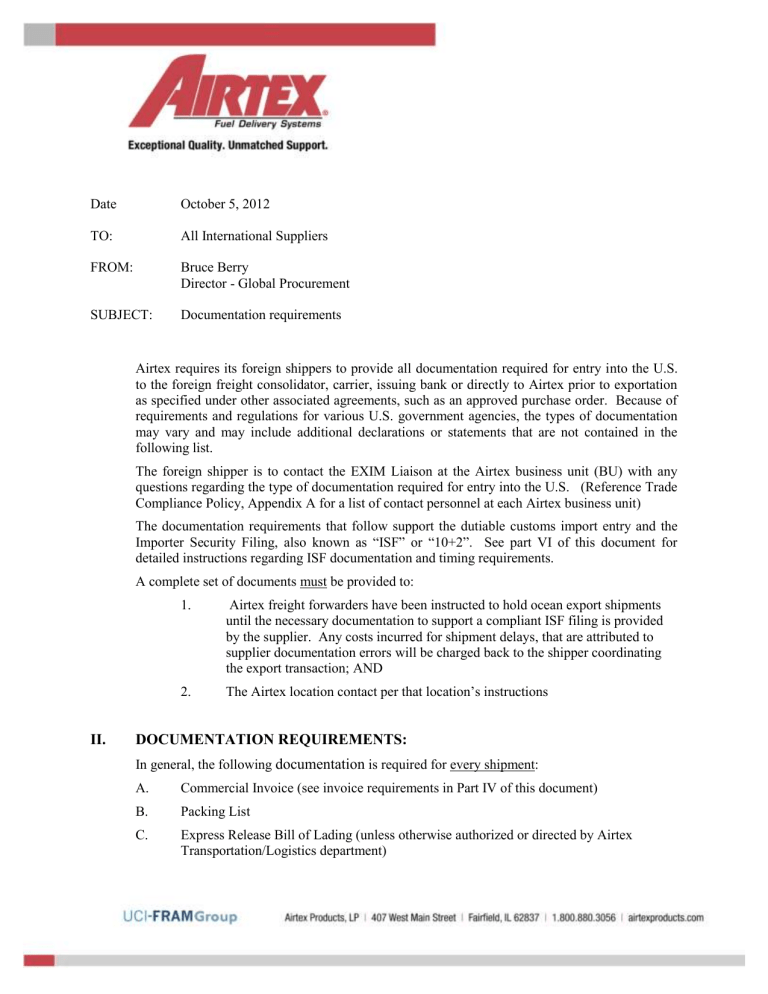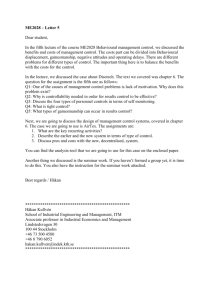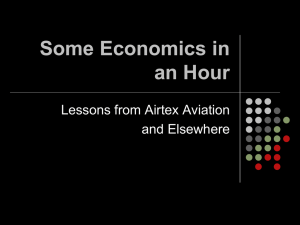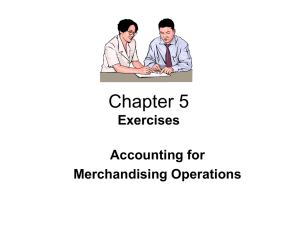Documentation Requirements

Date October 5, 2012
TO:
FROM:
All International Suppliers
Bruce Berry
Director - Global Procurement
SUBJECT: Documentation requirements
Airtex requires its foreign shippers to provide all documentation required for entry into the U.S. to the foreign freight consolidator, carrier, issuing bank or directly to Airtex prior to exportation as specified under other associated agreements, such as an approved purchase order. Because of requirements and regulations for various U.S. government agencies, the types of documentation may vary and may include additional declarations or statements that are not contained in the following list.
The foreign shipper is to contact the EXIM Liaison at the Airtex business unit (BU) with any questions regarding the type of documentation required for entry into the U.S. (Reference Trade
Compliance Policy, Appendix A for a list of contact personnel at each Airtex business unit)
The documentation requirements that follow support the dutiable customs import entry and the
Importer Security Filing, also known as “ISF” or “10+2”. See part VI of this document for detailed instructions regarding ISF documentation and timing requirements.
A complete set of documents must be provided to:
1.
2.
Airtex freight forwarders have been instructed to hold ocean export shipments until the necessary documentation to support a compliant ISF filing is provided by the supplier. Any costs incurred for shipment delays, that are attributed to supplier documentation errors will be charged back to the shipper coordinating the export transaction; AND
The Airtex location contact per that location’s instructions
II. DOCUMENTATION REQUIREMENTS:
In general, the following
documentation
is required for every shipment:
A.
B.
C.
Commercial Invoice (see invoice requirements in Part IV of this document)
Packing List
Express Release Bill of Lading (unless otherwise authorized or directed by Airtex
Transportation/Logistics department)
I.
A.
B.
C.
Free Trade Agreement Certificate of Origin (if applicable)
For ocean shipments only, documentation containing the following data elements to support the Importer Security Filing (also known as “ISF” and “10+2) is required.
(Reference PI-023, ISF Requirements)
Material Safety Data Sheet (MSDS) for chemical products and others, as applicable.
All finished goods, components, and/or various materials must meet or exceed the requirements for air shipment per IATA regulations.
D. Other U.S. government agency documentation and declarations, such as the Federal
Communications Commission, Food and Drug Administration, Fish and Wildlife,
Department of Transportation, and Environmental Protection Agency.
US CUSTOMS COMMERCIAL INVOICE REQUIREMENTS:
C.
D.
E.
With the enactment of U.S. Treasury Directive 02-62 on December 2, 2002, it is a requirement for shippers to provide complete and accurate product descriptions and/or tariff information to the six-digit level to the entities providing the cargo manifest to CBP 24 hours prior to the cargo being laden on board.
If accurate descriptions are not provided, the cargo can be denied loading onto the shipping vessel. This regulation applies to all ocean cargo destined for the United States, whether the cargo is to remain in the United States or be transported in-bond to another country. These regulations have been implemented as well for air and truck cargo as of December 2003.
In addition, under Title 19 of the Code of Federal Regulations (19 CFR §141.86), commercial invoices are required to provide the following information in English:
A.
B.
Date of invoice
The “Port of Entry” to which the merchandise is destined
The place of origin from where the goods are being shipped
The name and address of the seller, or shipper if not a direct purchase transaction.
A
1. detailed description of the merchandise including the following:
The common name of the merchandise
B.
C.
2.
3.
The grade or quality
The marks, numbers and symbols under which each item is sold and packaged
4. The quantities in the weights and measures of the country or place of export or in the weights and measures of the United States
The purchase price of each item 5.
The currency of the transaction
All relevant charges must be itemized by name and amount, such as:
D.
E.
F.
G.
H.
I.
B.
1.
2.
3.
4.
5.
Freight, if included in the price of the merchandise;
Insurance, if included in the price of the merchandise;
Buying or selling commissions,
Cost of packing if not included in the price of the merchandise,
All charges, costs and expenses incurred in bringing the merchandise from alongside the carrier at the port of export to alongside the carrier at the first US port of entry.
All relevant discounts
The country of origin for each item; note that the country of origin is the country of manufacture, and may not be the country from which the merchandise is being shipped.
The terms of sale of the transaction (ex: FOB, CIF, FCA, etc.)
The entire invoice MUST be in English or be translated into English by the foreign supplier.
Goods or services furnished for production of merchandise not otherwise included in the invoice price (i.e. assists such as dies, molds, tools and engineering work.)
If the merchandise was subject to any of the following, the nature of the work or value added abroad should be noted as:
1.
2.
Merchandise subject to repair pursuant to a warranty (reference SOP PI-024)
Merchandise subject to repair *not* pursuant to a warranty (reference SOP PI-
024)
3. Merchandise subject to assembly abroad (reference SOP PI-024)
The name of a responsible employee of the exporter who has knowledge or who can readily obtain knowledge, of the transaction
II. ADDITIONAL AIRTEX INVOICE REQUIREMENTS:
A. The Airtex part number/SKU number, if applicable to the merchandise, must be listed on the commercial invoice.
B.
C.
The Airtex purchase order number must be listed on the commercial invoice.
The Harmonized Tariff Schedule number, to at least six digits , should be listed on the commercial invoice for each commodity type.
III. OTHER AIRTEX REQUIREMENTS:
A. High Security Seals: Airtex requires its foreign shippers to affix a high security seal to ocean containers destined to the U.S. that meets or exceeds the current PAS ISO 17712
Standards.
1. Foreign shippers should record the seal number, commodity type, purchase order number, container number, and name of the employee that sealed the container in a log, spreadsheet, or similar means for record keeping purposes.
2. The seal number is to be provided to the ocean carrier or consolidator for inclusion as a data element on the ocean bill of lading for verification purposes once it is received in the United States by Airtex.







